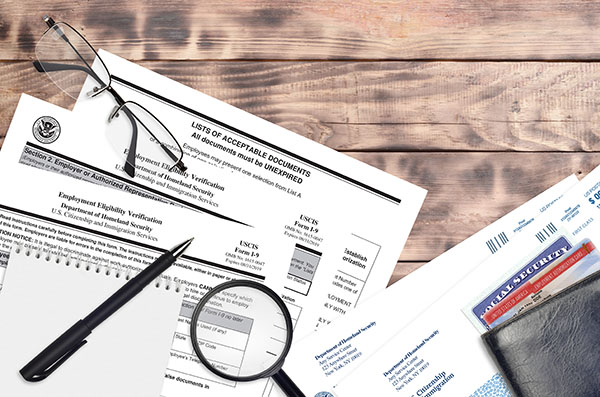Employer's Report: Employers Report Post
Read our CEA monthly newsletter, curated and written by our team of experts.
Missing out on the action?
Do You Have the Leave Forms You Need?
Posted by Giuliana Gabriel, Senior HR Compliance Director on May 28, 2025
Tags: Compliance, Leave Laws
An employee just informed you they need a month off work for surgery. In California, what forms do you need to provide?
As a California HR professional, bells should be ringing in your head about potential leave rights anytime an employee comes to you with a medical issue. As an employer with five or more employees, one of the first things you should consider is whether the California Family Rights Act (CFRA) may apply. If the answer is yes, make sure you have your leave forms ready to go!
What does CFRA require?
CFRA provides up to 12 workweeks of unpaid, job-protected leave, during a 12-month period, for covered reasons. This includes when an employee has a serious health condition, or is caring for a covered family member with a serious health condition, military exigencies for a covered family member, and baby bonding.
During CFRA leave, you must maintain and pay for an employee’s coverage under a group health plan (although the employee is required to pay their share of the premiums). You do not need to pay an employee’s salary during this time off, however, they may use accrued time, such as sick leave, vacation, or PTO. Employees may also apply for partial wage replacement with the EDD, such as state disability insurance and paid family leave, as applicable.
In terms of administrative requirements, all covered employers must:
- Implement a written CFRA policy
- Post the Civil Right Department’s CFRA poster, and
- Be ready to administer CFRA leave, including the required forms.
Let’s talk about forms!
Upon request for CFRA leave or learning an employee may qualify for CFRA:
1. Provide the Notice of Eligibility and Rights and Responsibilities
- As soon as practicable, but no later than five business days.
- This form notifies the employee whether they are eligible to take family and medical leave (i.e., 12 months of service, and 1,250 hours of service in the past year, and has not already exhausted leave, etc.), and whether you need certification regarding their reason for taking leave (i.e., to confirm they have a serious health condition, need to care for a covered family member, etc.).
2. Provide the Medical Certification Form as needed
- If you request a medical certification, employers must allow at least 15 calendar days for the employee to provide the certification, if practicable. Additional time may be required in some circumstances. Medical certification should not be requested for baby bonding leaves.
3. Provide the Designation Notice
- Within five business days of receiving sufficient information that the employee qualifies for CFRA leave (e.g., after receiving medical certification).
- This form lets the employee know whether the leave will be counted as family and medical leave or whether the request is denied.
4. Provide additional applicable notices, such as DE 2515 (State Disability Insurance) and DE 2511 (Paid Family Leave).
Looking for all of the forms you need in one place? Employers may purchase our Leaves of Absence Tool Kit on CEA’s Store, including the required California forms for CFRA/FMLA, Pregnancy Disability Leave, and reasonable accommodation leaves.
CEA members have access to over 20 different tool kits, including the Leaves of Absence tool kit by on the HR Forms page.
Form I-9 Enforcement: Does Your Company Need a Tune-Up?
Posted by Giuliana Gabriel, Senior HR Compliance Director on May 28, 2025
Tags: Compliance
Even the sleekest sports car built to perform needs a tune-up now and then. Without regular maintenance, any machine can eventually come to a screeching halt. The same holds true for a company’s Form I-9 practices. Regular audits ensure that HR practices aren’t becoming sloppy, leading to inadvertent mistakes, or failure to follow record retention requirements, leaving your company vulnerable to costly penalties.
With a new presidential administration and promise of increased immigration enforcement, it is prudent for all employers to review their onboarding processes, conduct regular audits of I-9 Forms, and be in the best position should you receive a Notice of Inspection.
In this article, we’ll pop the hood and review some of the most frequently asked questions about Form I-9. You can access the current Form I-9, Edition 1/20/2025 here.
When do we need to complete the Form I-9?
You must complete Form I-9 for newly hired employees to confirm identity and ensure they are authorized to work in the United States. Form I-9 is not required for independent contractors.
Section 1 – Employee Information and Attestation, must be completed at the time of hire (i.e., by the first day the employee starts work for pay). Section 2 – Employer Review and Verification, must be completed within three business days of the date employment begins. However, if you hire someone for less than three business days, you must complete the entire form no later than the first day of employment.
Can I inspect documents remotely?
Physical inspection is generally required. Only employers who participate in E-Verify in good standing and satisfy certain requirements are qualified to remotely examine documents. If you remotely verify, you must also check the alternative procedures box on the I-9 Form. Learn more here.
Do we have to keep copies of identity and work authorization documents, such as a Passport?
It is generally up to the employer to decide whether to keep copies of documents or not. Whatever you decide though, be sure to apply that rule consistently across new hires. Note that employers who participate in E-Verify are required to keep copies of certain documents.
Can employers use the Spanish I-9 Form?
Generally not. Although there is a Spanish version, it can only be used for translation purposes for a Spanish-speaking employee. You must use the English version to actually complete Form I-9. The only exception is that employers in Puerto Rico are permitted to use the Spanish version.
When is reverification required?
Reverification is required for certain employment authorization documents that are set to expire. Supplement B on the Form (formerly known as Section 3) is used for reverification. Learn more here. Note that reverification is never required for:
- U.S. citizens & non-citizen nationals
- The following documents:
-
- U.S. passports, U.S. passport cards
- Unexpired Permanent Resident or Alien Registration Receipt Card (Form I-551)
- Expired Permanent Resident Card presented with Form I-797
- List B identity documents (e.g., driver’s license)
How long do we need to retain I-9 Forms?
You should have I-9 Forms on file for all current employees. For former employees only, you may get rid of I-9 Forms/documentation one year after the end of employment, or three years after their first day of employment, whichever comes later.
How do I make corrections on the I-9 Form if I find a mistake?
Generally, the best way to correct errors on Form I-9 is to draw a line through the incorrect information, enter the correct information above or to the side of it, initial and date the correction. Prepare a written explanation and attach it to the original form. Sometimes, major errors require completing a new I-9 Form, but always keep a copy of the original.
Never use white out, attempt to conceal errors, or backdate your entries. Retain all original I-9 Forms and documents in accordance with record retention requirements.
Whether the employer (including an authorized representative) or the employee must make the correction depends on the section(s) at issue. Learn more here.
How can I get help in auditing my I-9 Forms?
If you need an I-9 tune up, CEA can assist you. CEA members have access to our I-9 Self Audit Toolkit here. Or, let CEA do the work for you and inquire about our I-9 Audit Service for employers by calling 800.399.5331.
California Appeals Court Approves Advance Meal Period Waivers
Posted by Virginia Young, HR Compliance Director on May 28, 2025
Tags: Compliance, Wage and Hour
A California appeals court affirmed that employees may make written waivers in advance for workdays of 6 hours or less, as long as the waiver is knowing and voluntary and can be revoked at any time without retaliation. This decision welcomes confirmation of the advance written meal period waiver practice, but employers should heed the court’s warning about potential pitfalls.
Meal Period Refresher
As a refresher, California law requires employers to provide a 30-minute, off-duty and unpaid meal period for employees who work more than five hours in a day and a second 30-minute off-duty and unpaid meal period when they work more than 10 hours. Employers owe an extra hour of pay at the employee’s regular rate for any day the employer does not provide all required meal periods.
However, California law allows employees to waive a meal period in the following circumstances: if the employee’s total work per day is no more than six hours, the employee may waive their meal period with the agreement of the employer. If the total work for the day is no more than 12 hours, the employee may waive the second meal period with the employer’s agreement, as long as the employee took their first meal period.
The Bradsbery Case: A Written Advance Waiver With No Evidence of Coercion Passes Muster
In Bradsbery v. Vicar Operating, Inc. (2nd Appellate District, Case No. B322799), the plaintiffs sued their employer for meal period premiums. Both had signed written meal period waivers at the beginning of their employment. The waivers stated:
I hereby voluntarily waive my right to a meal break when my shift is 6 hours or less. I understand that I am entitled to take an unpaid 30-minute meal break within my first five hours of work; however, I am voluntarily waiving that meal break. I understand that I can revoke this waiver at any time by giving written revocation to my manager.
The employees argued that the court should not enforce the waivers because they were signed before the workday was scheduled. According to plaintiffs, advance waivers do not protect employees, only favor the employer, and “eviscerate” employee meal break protections.
The trial court sided with the employer, and the appeals court agreed, holding that the advance, revocable written waivers plaintiffs signed were enforceable “in the absence of any evidence the waivers are unconscionable or unduly coercive.”
A Couple Of Caveats
The Bradsbery decision is great news, but employers should take note of a couple of important caveats.
In reaching its decision, the court found that there was no evidence the waivers were unconscionable or unduly coercive. The court stated it would have serious reservations about a waiver if presented with evidence that the employee signed the waiver unknowingly or under coercion by the employer, or if the employee could not exercise the right to revoke the waiver freely.
It is also important to note that the court’s decision is limited to written waivers. The court expressly declined to consider or decide whether prospective oral waivers of meal periods are permitted.
Employer Takeaways
The Bradsbery decision confirms that written advance meal period waivers for workdays between 5 and 6 hours can be enforceable. However, the court’s decision makes clear that getting the written waiver on file is not the end of the story. Employers should make sure waivers are in writing, clearly explained to employees, and that employees’ rights to choose not to sign or to revoke at any time without retaliation are respected.
Have questions about meal break waivers or wage and hour practices in general? Check out our membership options to join online now, or give us a call, and we’ll walk you through how we can support your business and bring you peace of mind.
Kim’s Message: Is This the Best You Can Do?
Posted by Kim Gusman, President & CEO on May 27, 2025
Tags: Leadership
A Leadership Lesson from Henry Kissinger
I love to give people praise for good work. However, I recently heard that one of the most powerful things a leader can do isn’t to offer immediate praise or give constructive criticism-instead, it’s asking the right question. I have learned that one question, made famous by former U.S. Secretary of State Henry Kissinger, has quietly shaped the way many high-performing teams think about standards and accountability, and that question is: Is this the best you can do?
This simple phrase carries a lot of weight. It’s a challenge and also an invitation to reflect, to go deeper, and to take ownership of your work. The story behind it is one worth sharing, not just for its humor, but for what it reveals about the pursuit of excellence in any field.
The Story
As the story goes, Kissinger once asked one of his top speechwriters to draft a speech on foreign policy. The writer worked hard on it, submitted the draft, and waited. Instead of feedback, Kissinger returned the document with a single question: “Is this the best you can do?” Taken aback, the writer revised the speech, improving structure and tightening arguments. He handed it back with more confidence. Kissinger responded again: “Is this the best you can do?” This exchange repeated itself several times. Each time, the writer dug deeper, refined further, and questioned his assumptions. Finally, after several iterations, the exasperated speechwriter submitted the revised draft with a note: “Yes, this is the best I can do.” To which Kissinger famously replied: “Good. Then I’ll read it now.”
The Lesson: Excellence Is a Mindset
Kissinger’s approach wasn’t about playing mind games or demanding perfection for perfection’s sake. He was doing something that great leaders often do: encouraging personal ownership and excellence without micromanaging. His question prompted the writer to become their own harshest editor-to not just meet expectations, but to exceed them voluntarily. By pausing and reflecting on whether the work truly represented their best effort, the writer grew-and so did the work.
When we ask ourselves or our team members, “Is this the best you can do?” it forces us to pause and reflect:
- Did I approach this with full effort?
- Did I settle for acceptable instead of striving for exceptional?
- Am I proud of what I’m submitting?
In a world that moves fast and often rewards speed over substance, Kissinger’s question is a bold invitation for all of us to slow down and think deeply. This has been a helpful lesson for me in my work, and now I want to apply it as a leader.
Why This Matters for Today’s Leaders
In a world that moves quickly, it’s easy to prioritize speed over depth, or completeness over thoughtfulness. But leadership isn’t just about getting things done-it’s about coaching others to grow and develop. Kissinger’s story reminds us of three essential truths:
- Excellence is a habit. It doesn’t happen by accident; it must be cultivated and reinforced through culture and expectation.
- Feedback isn’t always a red pen. Sometimes, a single question does more to unlock potential than a thousand notes.
- The best work comes from within. When people push themselves to a higher standard-not because they’re told to, but because they believe in the work-the results speak for themselves.
You don’t need to be a diplomat to make use of this principle. Try using it on yourself as well as incorporating it into your team culture:
- Before giving feedback, ask: “Do you feel this is your best work?”
- Let people reflect before rushing to revision-it encourages personal pride and deeper thinking.
- Build a culture where striving for better isn’t about pressure, but about shared pride in the work.
Final Thought
Kissinger’s question is simple. Yet behind it lies a profound leadership philosophy: people often have more to give-if you trust them to find it. As leaders, we have a responsibility to help others rise to their highest potential. So next time you’re reviewing a draft, listening to a pitch, or evaluating a proposal, consider asking: “Is this the best you can do?” And then wait. Excellence begins with that pause.

Mark Your Calendar May & June Events!
Posted by California Employers Association on May 27, 2025
Tags: Training & Development
Have you ever been curious about your natural talents? A CliftonStrengths StrengthsFinder assessment can help you identify what you are naturally best at, helping to unlock greater career satisfaction and success. Join our certified coaches on May 20, and engage in discussions to help you deepen your understanding of how to apply your unique strengths to excel in your career.
Upcoming Event Schedule Dates Event Type June 2025 Jun 3
 Virtual Event
Ultimate Members Only: Hire Right the First Time
10:00 AM – 11:00 AM
REGISTER NOW
Jun
5
Virtual Event
Ultimate Members Only: Hire Right the First Time
10:00 AM – 11:00 AM
REGISTER NOW
Jun
5
 Virtual Event
Workplace Violence Prevention Plan – Do it Yourself Package
10:00 AM – 11:30 AM
REGISTER NOW
Jun
10
Virtual Event
Workplace Violence Prevention Plan – Do it Yourself Package
10:00 AM – 11:30 AM
REGISTER NOW
Jun
10
 Virtual Event
CEA Member Benefits Overview
1:30 PM – 2:00 PM
REGISTER NOW
Free for Employers!
Jun
11
Virtual Event
CEA Member Benefits Overview
1:30 PM – 2:00 PM
REGISTER NOW
Free for Employers!
Jun
11
 Virtual Event
Helping Managers Navigate Conflict and Hard Conversations
12:00 PM – 1:30 PM
REGISTER NOW
Jun
18
Virtual Event
Helping Managers Navigate Conflict and Hard Conversations
12:00 PM – 1:30 PM
REGISTER NOW
Jun
18
 Virtual Event
2025 Mid-Year Labor Law Update
10:00 AM – 11:00 AM
REGISTER NOW
Jun
25
Virtual Event
2025 Mid-Year Labor Law Update
10:00 AM – 11:00 AM
REGISTER NOW
Jun
25
 Virtual Event
CEO Monthly Roundtable Series
9:00 AM – 10:30 AM
REGISTER NOW
July 2025
Jul
8
Virtual Event
CEO Monthly Roundtable Series
9:00 AM – 10:30 AM
REGISTER NOW
July 2025
Jul
8
 Virtual Event
CEA Member Benefits Overview
1:30 PM – 2:00 PM
REGISTER NOW
Free for Employers!
Jul
9
Jul
30
Virtual Event
CEA Member Benefits Overview
1:30 PM – 2:00 PM
REGISTER NOW
Free for Employers!
Jul
9
Jul
30
 Virtual Event
Mastering Interpersonal Skills Series
Wednesdays
4-Part Series
July 9 10:00 AM – July 30 12:00 PM
REGISTER NOW
Jul
10
Virtual Event
Mastering Interpersonal Skills Series
Wednesdays
4-Part Series
July 9 10:00 AM – July 30 12:00 PM
REGISTER NOW
Jul
10
 Virtual Event
Harassment Prevention Training for Employees and Supervisors
10:00 AM – 12:00 PM
REGISTER NOW
Jul
15
Virtual Event
Harassment Prevention Training for Employees and Supervisors
10:00 AM – 12:00 PM
REGISTER NOW
Jul
15
 Virtual Event
FREE: Form I-9 Overview (Presented by USCIS)
10:00 AM – 11:00 AM
REGISTER NOW
Jul
23
Virtual Event
FREE: Form I-9 Overview (Presented by USCIS)
10:00 AM – 11:00 AM
REGISTER NOW
Jul
23
 Virtual Event
CEO Virtual Roundtable Series
Exclusively for CEO’s
9:00 AM – 10:30 AM
REGISTER NOW
Panel only seen by widget owner
Edit widget
Views
0%
Extend Limit
Share
Virtual Event
CEO Virtual Roundtable Series
Exclusively for CEO’s
9:00 AM – 10:30 AM
REGISTER NOW
Panel only seen by widget owner
Edit widget
Views
0%
Extend Limit
Share
 Tell your customers about
Tell your customers aboutnew website functionality!
WVPP Reminder: It’s Time for Training!
Posted by Eli Nuñez, HR Director on May 15, 2025
Tags: Compliance
It is hard to believe that almost a year has passed since SB 553 went into effect on July 1, 2024 in California, requiring employers to develop and implement workplace violence prevention plans. The law applies to most employers in the State with a few exceptions.
- If your business put a plan in place when the requirement came into effect, now is the time to revisit it and schedule the required yearly training for your employees.
- If you are required to have a plan but have not created one yet, it’s time to do so ASAP! Employers who fail to comply with the requirements may be subject to penalties of up to $25,000 for serious violations and up to $158,727 for willful violations so procrastination could prove to be expensive.
Exceptions to the law include:
- Employers already covered by the WVPP in Healthcare Standard
- Facilities operated by the California Department of Corrections and Rehabilitation
- Law enforcement agencies
- Employees teleworking form a location of their choice that is not under the control of the employer
- Places of employment that are not accessible to the public and have less than 10 employees working at any given time, so long as they have a compliant IIPP.
Training Timelines
As a reminder, all California employers must have a written Workplace Violence Prevention Plan (WVPP) and provide training to employees on the employer’s plan:
- Whenever new hazards are identified,
- whenever the plan is changed, and
- on an annual basis.
WVPP Employee Training Requirements
The person conducting any of the WVPP trainings must be knowledgeable in the employer’s WVPP. The training must be customized to the specific workplace and any hazards present meaning a generic “off the shelf” training may not meet the requirements.
The training materials and content used by the employer should also be appropriate for the educational level, literacy, and language of their employees. In other words, if you communicate with your workforce in a language other than English then the training materials and plan content should match that language. Training records must also be retained for a minimum of one year.
The law also states that the training must cover specific definitions in Labor Code section 6401.9 as well as:
- The employers specific WVPP
- How an employee can obtain a copy of the employer’s plan
- How to report incidents of workplace violence and retaliation/reprisal protections
- Violence hazards specific to the employee’s job
- The corrective measures the employer has implemented to address hazards
- Strategies to avoid physical harm
- How to seek assistance to prevent or respond to violence
- How to obtain copies of records regarding hazard identification, evaluation and correction and training records
- The Violent Incident Log-what it is and how to obtain a copy.
Employers can also include supplemental information such as:
- Defusing confrontations
- Escape plans
- Active shooter trainings
Creating the WVPP Employee Training
If you need assistance creating your employee training, CEA has a training template with 30+ slides to incorporate the requirements and key definitions to present the materials to your staff. The WVPP employee training template allows you to easily customize your plan so that a trainer familiar with the nuances of your business can modify it and present it to your team. It is available for purchase in the CEA Store – CEA members receive a discounted rate!
Just Getting Started?
If you are just starting your WVPP, CEA has a comprehensive Do-It-Yourself Package available for administrators/employers, which includes a 90-minute training recording and toolkit to guide you through the process and ease the headaches. Join us for our live webinar on June 5, 2025 at 10:00am. The live webinar includes the DIY package and walks you through everything you need to know, step by step!
Reminder: CEA members already have free access to our WVPP Tool Kit!
Important Pay Data Reporting Deadlines
Posted by Virginia Young, HR Compliance Director on May 8, 2025
Tags: Alert, Employers Report
*Important Update* EEOC opened the EEO-1 Reporting Portal on May 20, 2025. The deadline to file the 2024 EEO-1 Component 1 report is Tuesday, June 24, 2025. Employers can access updated instructions and information and get started here.
Springtime brings us allergies, nicer weather, and excitement about summer travel plans. It also represents pay data reporting season for large employers and federal contractors. Are you up to date with state and federal requirements?
California Pay Data Reporting
As a refresher, California law requires private employers of 100 or more employees and/or 100 or more workers hired through labor contractors to annually report pay, demographic, and other workforce data to the Civil Rights Department.
California’s reporting deadline is the second Wednesday of May each year. For 2024 data, the reporting deadline lands on May 14, 2025. Covered employers can learn more here. Note this is separate and in addition to the federal EEO-1 Component 1 data collection.
What is the EEO-1 Component 1 Data Collection?
Similar to California’s pay data reporting requirement, the EEO-1 Component 1 report is a mandatory annual data collection that requires all private sector employers with 100 or more employees to submit demographic workforce data, including data by race/ethnicity, sex, and job categories.
Federal contractors with 50 or more employees meeting certain criteria have also been required to file EEO-1 Component 1 reports.
- The revised instruction booklet continues to direct federal contractors with at least 50 (but fewer than 100) employees to file, without mention of President Trump’s January, 2025 revocation of EO 11246. EO 11246 is the Executive Order that created the obligation for federal contractors with fewer than 100 employees to file EEO-1 reports. With President Trump revoking that Order, it creates ambiguity as to whether this requirement is still in place. Contractors with fewer than 100 employees and questions about whether they are required to file should consult their counsel.
What Are the Revisions to the EEOC’s Instruction Booklet?
EEOC revised the instructions to eliminate the option to report non-binary employees. Employers will only be able to report employees as “male” or “female.” According to EEOC, this change is necessary to comply with President Trump’s Executive Order 14168, which states the federal government will recognize only two sexes-male and female.
Additionally, the EEOC will not send out “Failure to File” notices prior to the closing of the portal. It also included changes in the processing of undue hardship exemptions to reflect current regulations.
What Should Employers Do Now?
If you have 100 or more employees, and/or 100 or more workers hired through labor contractors, file as soon as possible with California’s Civil Rights Department, if you haven’t done so already. If you have 100 or more employees, or if you have 50 or more employees plus a federal contract that requires you to file the EEO-1 Component 1, make sure to submit by the June 24, 2025 deadline!
CEA members can call 800-399-5331 or email ceainfo@employers.org with additional questions.
EEOC and DOJ Issue Guidance on DEI-Related Discrimination
Posted by California Employers Association on May 1, 2025
Tags: Compliance
On March 19, 2025, the U.S. Equal Employment Opportunity Commission (EEOC) and the U.S. Department of Justice (DOJ) issued joint guidance on illegal and discriminatory diversity, equity and inclusion (DEI) practices. The EEOC also issued frequently asked questions (FAQs) regarding DEI-related discrimination. The guidance provides some clarity as to the agencies’ position on what may constitute illegal DEI and offers steps employees may take to report violations.
Background
On Jan. 20, 2025, and Jan. 21, 2025, President Donald Trump issued executive orders (EOs) 14151 and 14173, respectively, which seek to terminate all illegal DEI mandates, policies, programs, preferences and activities. However, neither EO defines what practices or programs may constitute illegal DEI. The EEOC and DOJ guidance provides some clarity as to the agencies’ positions on illegal DEI.
Note: For discussion of these Executive Orders, and their current status, please see CEA’s February 27 article.
Overview of DEI-related Discrimination Guidance
Under Title VII of the Civil Rights Act (Title VII), employers with 15 or more employees may not discriminate on the basis of an individual’s protected trait (e.g., race, color, religion, sex or national origin). The EEOC FAQs and the EEOC and DOJ joint guidance state that DEI programs may be unlawful under Title VII if they are motivated, in whole or in part, by an employee’s protected trait. The guidance identifies specific instances of potential DEI-related discrimination in the workplace, including:
- Disparate treatment in employment actions (e.g., hiring; firing; compensation; access to training, mentoring or workplace networking; and selection for interviews, including inclusion in a candidate pool) that is motivated by a protected trait;
- Limiting, segregating or classifying employees based on a protected trait in a way that deprives them of employment opportunities (e.g., limiting membership in workplace groups, such as employee resource groups or affinity groups, to members of a particular protected class);
- Engaging in workplace harassment based on a protected trait (e.g., DEI training may constitute illegal harassment if it is so severe or frequent as to be intimidating, hostile or abusive); and
- Retaliating against employees who engage in protected activity (e.g., objecting to DEI-related discrimination, participating in an investigation or filing a charge).
The guidance further clarifies that unlawful discrimination occurs even if a protected trait is just one factor among several rather than the sole factor. Additionally, employers may not justify taking an employment action on the basis of a protected trait because they have a business interest in diversity, including a client or customer preference. Finally, the guidance provides steps employees may take to file a claim of discrimination with the EEOC.
Understanding the Pros and Cons of Split Shifts
Posted by Virginia Young, HR Compliance Director on May 1, 2025
Tags: Compensation, Compliance
Are you thinking of reducing labor costs by having hourly (non-exempt) employees clock out during non-peak hours? While a split-shift may be one way to cut expenses, other factors such as the employee’s rate of pay, the number of hours they work in a day, and whether a split shift pay premium is due may not actually result in any savings. Be sure you understand California’s split-shift pay requirements before creating that next work schedule.
What is a Split Shift?
A “split shift” is a work schedule where the workday is interrupted by a non-paid and non-working time period that is longer than a bona fide meal period. The break between shifts cannot be a meal or rest break.
- Example: A fitness instructor who is scheduled by the employer to work from 6 am to 8 am, and then again from 5 pm to 7 pm is working a split shift.
The schedule must be to the benefit of the employer and established by the employer. There are some exceptions:
- If an employee requests the break for their own convenience, then it is not a split shift.
- An employee who volunteers to work a second shift is not working a “split shift.”
- There is also an exception for employees who reside at their place of employment.
What are the Consequences of Having a Split Shift?
Employees who work split shifts may be entitled to a split shift premium for each day a split shift occurs. The premium is one hour of pay at the state minimum wage (currently $16.50/hour) or the local minimum wage if that is higher.
A Higher Hourly Rate can Reduce or Eliminate the Split Shift Premium
Money earned for the workday in excess of the state or local minimum wage (whichever is higher) is credited towards the split shift premium. This means that employees making more than the minimum wage per hour will be entitled to smaller split shift payment, or maybe no split shift payment at all.
- Example: Assume the fitness instructor above earns $20/hour and there is no local minimum wage.
- Because she worked four hours in a workday that included a split shift, the minimum wage for her workday is $82.50 (4 hours worked times $16.50 plus an additional $16.50 for the split shift premium).
- The employee earns $80 for her 4 hours worked at $20/hour. After credit for this payment at her hourly rate, the split shift premium due is $2.50 ($82.50 – $80).
- The $2.50 split shift premium must be itemized on her paystub.
As the example illustrates, the amount of split shift due, if any, depends on the applicable minimum wage, the employee’s hourly wage and the number of hours they work in the day. Members can use CEA’s Split Shift Compensation Table to help with calculations.
Additional Scheduling-Related Requirements
In addition to split shifts, California employers need to be aware of other scheduling relating requirements for non-exempt employees, such as “Reporting Time Pay” and, of course, meal and rest breaks. Local predictive scheduling ordinances can also apply.
California’s Wage and Hour rules can be tricky. CEA members with questions can call our experienced HR advisors for assistance.
California Court Addresses Extended Leave Requests
Posted by Giuliana Gabriel, Senior HR Compliance Director on May 1, 2025
Tags: Compliance, Leave Laws
A difficult issue, that employers often face, occurs when an employee has exhausted all protected leave time (such as CFRA/FMLA), and then requests an extension of unpaid leave as an ADA/FEHA reasonable accommodation. Medical leave can qualify as a reasonable accommodation if it enables an employee to recover and return to work. However, it can be frustrating to navigate when the employee requests multiple extensions with no clear end date in sight. Employers will call and ask us if they have to allow a leave to continue indefinitely.
Good News for California Employers!
The 2025 case, George Manos v. J. Paul Getty Trust, reaffirms that employers are not obligated to provide “indefinite leave” as a reasonable accommodation. And, this case also highlights the importance of good faith efforts by the employer to engage in the interactive process.
Facts of the Case
An HVAC technician at the Getty, George Manos, fell off of a ladder while working and fractured his leg in June 2019. Manos’ doctor first estimated he would be able to return to work in November 2019. However, over the course of almost a year, Manos requested multiple leave extensions:
- Manos first exhausted his 12 weeks of family and medical leave and continued to be off work through November.
- Manos then submitted extended leave requests to return in January 2020, and then again in April 2020.
- By April 2020, Manos submitted his fourth request for “indefinite” medical leave, estimating return in July 2020.
- Getty reached out to Manos to engage in the interactive process and requested he complete an “Interactive Process Questionnaire” regarding whether any reasonable accommodations would allow him to return to work. Manos responded that he was not requesting any accommodations “at this time,” checked a box for “continuous leave,” and stated his return to work date was “unknown.”
Getty made the decision to terminate Manos’ employment. Manos sued, claiming that Getty failed to engage in the interactive process and reasonably accommodate Manos.
Court Findings
The Court of Appeal found in favor of the employer, Getty, highlighting the following:
- The only accommodation Manos requested following his workplace accident was medical leave “which the Getty repeatedly granted-ultimately for about a year.”
- Three of the four leave requests were for “indefinite” leave, including the fourth and final request.
- When Manos completed the questionnaire, he did not request any other accommodations. Instead, he indicated he could not return to work and requested only “continuous leave.”
Takeaways for Employers
While employers are not obligated to provide “indefinite leave,” there is no bright-line rule regarding the duration of a reasonable accommodation leave. In this case, the employer was able to demonstrate good faith efforts in granting three leave requests. The employer reached out to engage in the interactive process and explore other reasonable accommodations that would allow Manos to return to work.
The Manos case provides employers a good framework on what to do when dealing with multiple leave requests. However, given the gray area in the law, it is always best to consult legal counsel before ending employment in these situations, to ensure you have satisfied all requirements under the ADA/FEHA and other laws.
For more information on reasonable accommodation requirements, CEA members may refer to our Reasonable Accommodations Toolkit page.
Kim’s Message: Pardon Our Dust…Exciting Changes Ahead!
Posted by Kim Gusman, President & CEO on May 1, 2025
Tags:
I hope this message finds you well and thriving within our CEA community. As we step into May, we’re excited to share some updates that will enhance your membership experience and reinforce our commitment to supporting your HR needs.
In the coming months, we’ll be transitioning from our current system-which we’ve proudly outgrown-to a new, more robust database. As with any major upgrade, there may be occasional hiccups or brief service interruptions while we work through the transition and get comfortable with the new system.
Thank you for your trust and support-you’re the reason we keep growing and improving!
Here’s a sneak peek at the CEA enhancements coming in the second half of 2025:
- Live Chat Support: We now have a Live Chat feature on each page of our website. Quick answers when you need them-now via phone, email, or live chat!
- A New Website Launching in June: Faster, easier, and designed with you in mind.
- A New Member Portal: As we transition to our new association management system, members will be asked to log in through a new member portal for a smoother, more efficient experience.
These improvements are all about giving you more support, better tools, and greater value. Thanks for your patience as we make the transition. Please pardon our dust as you explore the new website in June, and don’t hesitate to reach out to our team with any questions along the way.
We look forward to continuing to serve you in 2025 and beyond!
Why Variable Pay is a Part of Competitive Compensation Programs
Posted by Olivia Steelman, Compensation Consultant, Cascade Employers Association on April 24, 2025
Tags: Compensation
Despite the economic uncertainty in the U.S. right now, organizations are still pushing forward with including variable pay as part of their overall compensation strategy and compensation programs to retain top talent. Variable pay is compensation awarded to employees, in addition to their base pay. Generally, variable pay plans (bonuses) are based on performance measures.
Bonus plans at all levels are still in place. They seek to provide extra pay for meeting specific outcomes on top of the employee’s agreed-upon base salary.
Bonus Types
An organization may utilize several types of bonuses, such as:
- Spot bonus: Used to recognize a successful project and/or moment of exceptional performance.
- Retention bonus/longevity bonus: Rewards increasing tenure at the same organization.
- Sign-on bonus: Offered to new hires to encourage joining the organization/accepting a job offer.
- Referral bonus: Rewards current employees who recommend a candidate who is successfully hired by the employer. Referral bonuses can be provided at the time of hire, after 90 days of employment, or the plan may allow for a partial payment on the hire date, with the remaining amount of the bonus being paid out after 90 days.
- Performance bonus: Used to provide additional incentive to meet business-specified metrics tied to organizational goals.
Some organizations may use multiple bonus types as part of their variable pay strategy to reward for different reasons. For example, an organization currently short-staffed may temporarily decide to offer a referral bonus to employees who bring in new applicants for hire.
Performance bonus programs should include specific metrics before payouts occur. Bonus targets can be set by job level, type of role, specific positions, or something entirely different. Regardless of your plan, it’s best practice to have consistent bonus targets for roles of comparable character to ensure individuals performing similar work are eligible for similar pay.
A pay-for-performance strategy should be based on the performance factors outlined as part of the overall performance management program. Eligibility for the same level of bonus payout does not necessarily guarantee that each employee will receive a bonus, but the opportunity to earn it is equal.
Designing Your Bonus Plan
When designing a bonus plan, explicitly state who is eligible and under what circumstances an employee has the opportunity to achieve a specific bonus. Other information, such as the expected timing of a payout, can be valuable to have in your employee handbook or policies manual. Including eligibility guidelines, such as “must be employed for a minimum of 6 months to be eligible for a spot bonus”, provides necessary clarity to employees and managers.
Note for California Employers: When paying out a bonus or designing a bonus plan, it’s critical to clarify whether the bonus being given is discretionary or non-discretionary.
The Difference Between Discretionary and Non-Discretionary Bonuses
While a discretionary bonus is paid at an employer’s discretion, a non-discretionary bonus is paid based on predetermined criteria. In other words, an employer can decide to give an employee a discretionary bonus without any criteria or strings attached. Think end-of-year holiday bonus or a spot bonus for a job well done. A non-discretionary bonus is based on previously agreed upon criteria (think of a production goal that is tied to a number or percentage).
Have More Questions?
CEA partners with our sister association, Cascade Employers Association, to provide you with a team of Compensation Experts. They can handle everything from designing a bonus plan to reviewing your current compensation plan to help you create a compensation plan from scratch! Reach out to their compensation team for custom support!

